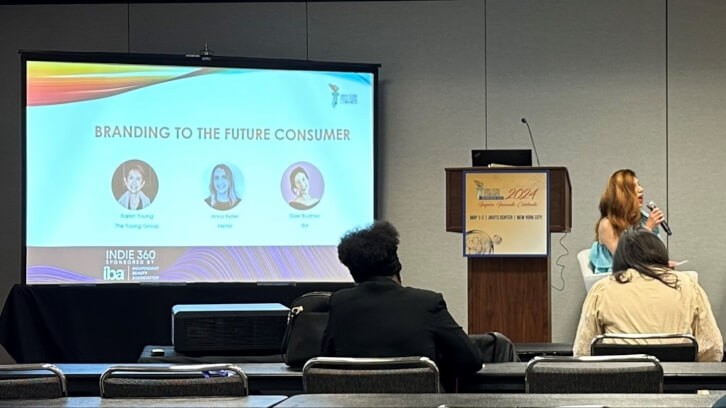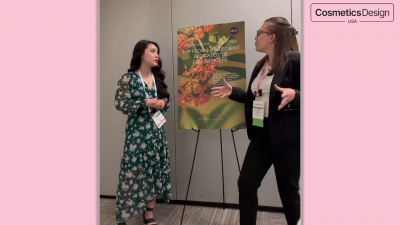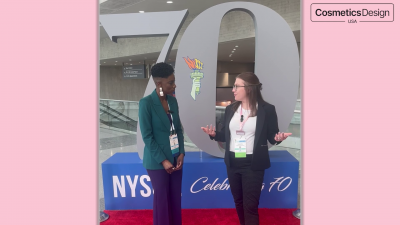NYSCC Suppliers’ Day: INDIE360° track key takeaways

NYSCC Suppliers’ Day 2024 programming included a well-attended panel discussion track entitled “INDIE360°,” an exclusive panel series sponsored and curated by the Independent Beauty Association (IBA) designed to “provide indie beauty brands with invaluable insights, industry trends, and networking opportunities,” according to an IBA press release. The event’s panel series included several crucial topics for indie brands looking for the most current information on MoCRA, Supply Chain and AI, the Future of Branding, and more.
For deeper insights across the panel sessions, we interviewed several of the events participants for their key takeaways.
Panel: Branding to the future consumer
This session examined current cosmetics industry trends that are on the rise and others that are falling out of favor. We spoke to moderator Eber Bodmer, Vice President, Marketing & Communications at IBA and panelist Karen Young, CEO at The Young Group to learn more. They were joined on the panel by Anna Keller, Principal Analyst at Mintel.
CDU: What were the key insights shared during the panel session on "Branding to the Future Consumer”?
Eber Bodmer (EB): I joined Karen Young, The Young Group and Anna Keller of Mintel to talk about how indie brands should approach branding to the next generation: Gen Alpha.
The main point made on the panel is that though the concept of marketing to a younger consumer is not novel (it’s been going on for hundreds of years... think toys in cereal boxes) what has changed is the access of information with Gen Alpha being on their devices all the time. According to Mintel’s Gen Alpha Report (2024), 54% of US 12–14-year-old beauty users who are on social media keep up with beauty trends and often purchases these items.
The experiential aspect of how this generation interacts with brands require an omni-channel strategy, and when developing your physical in-store experiences, creating sensorial play areas is vital.
CDU: How do you think branding strategies need to evolve to resonate with the future consumer?
EB: Mintel’s research emphasizes building a strong brand story focusing on sustainability, inclusivity, and empowerment (e.g. circular design, products for all skin tones, hair textures and body types). It is essential to work with your legal teams and define those demographics and revise your education and brand messages.
However, building a brand strategy starts at the first touchpoint of product inception. Work with your suppliers and product developers because what’s in the product vs. who your demographic is vs. what education and brand messaging is needed.
Put up guardrails for yourself. You cannot always control how a consumer, especially this age group, would use your product but you can set up expectations, directions, educate and be transparent in your messaging.
CDU: Can you discuss any specific case studies or examples that were mentioned during the session?
EB: I spoke about when I helped launch a brand for a younger consumer within Ulta, and how AmorePacific also leaned into this demographic in re-launching Laneige in Sephora. A strong story, a fun story is essential, but you must be very clear from the start as to the goal of the SKU.
We had a lip mask that had acids, and we had to explain that it will exfoliate and to not use on other areas on the face because there was a glossy, wet lid trend happening at the time.
You must work with all the teams involved with creating a strong branding message. Your marketing must be informative and transparent. You cannot just market for sensation or dollars, and this is even more apparent with Gen Alpha.
Karen Young (KY): I spoke about a client of mine, an Indie brand named Talomi, which strived for a fun alternative in brand messaging. I also spoke about its product simplification – a multi-stick that can be used anywhere, with an emphasis on fun, safe, and clear messaging. Today, the brand is now making some messaging adjustments to address parents as well as the young teens.
CDU: In your opinion, what are the most important factors for brands to consider when targeting the future consumer?
EB: Anna Keller at Mintel highlighted that Gen Alpha consumers are often now the ones with the purchasing power versus the parent. So, be diligent in understanding the shift in purchase decision making. She also highlighted the value proposition in terms of brands getting more traction with authentic messages.
CDU: Were there any notable discussions or debates that arose during the panel session?
KY: Important drivers for this demographic include experiential products, playfulness, creativity, self-expression, education and transparency. Many brands have taken a stand in terms of their prudent, thoughtful relationship with young teens.
These young consumers feel pressure from social media, influencers and peers and beauty products are part of that, like it or not. Significant growth for retailers and brands is coming from this demographic.
Contract packaging: State of the industry report
This session examined the current state of the contract packaging industry for cosmetic and personal care product manufacturers, suppliers, and brands. We interviewed Dr. Akemi Ooka, Head of Global Supply Chain Resources at the IBA, who was extensively involved in the planning and facilitating this presentation, which Carl Melville, Managing Partner at The Melville Group, LLC, led.
CDU: What were the main findings presented in the "Contract Packaging: State of the Industry Report"?
Dr. Akemi Ooka (AO): The Contract Packaging and Manufacturing industry is robust and growing, though there continues to be consolidation in the industry—partially driven by owners retiring and the strong profitability of the sector.
CDU: How do these findings impact the current landscape of contract packaging?
AO: The CP/CM industry remains strong, and many more companies (large and small) are turning to contract manufacturing – companies can both start new product innovation or sunset legacy product lines through contract manufacturers, so they are increasingly important for both indie brands and large brands
CDU: Were there any trends or emerging practices highlighted in the report that surprised you?
AO: That women and minority owned and run contract manufacturing and packaging was abysmally low and has stayed low for several years—there is much opportunity tied to supplier diversity efforts, especially with large companies.
CDU: How do you foresee the contract packaging industry evolving soon based on the insights shared?
AO: The industry will continue to grow, and likely continue to consolidate. They are challenged with respect to labor—an aging workforce, less skilled labor, and people opting out of manufacturing altogether—but also have opportunities with automation and tech. There is also still difficulty offering low MOQs for indie brands, as the operational costs continue to increase which puts pressure on short run campaigns.
For example, the changeover and cleanout costs are the same for a 1,000-unit order or a 1,000,000-unit order, but you can allocate the cost contribution more efficiently over the larger run size.
CDU: Were there any challenges or opportunities identified for businesses operating in the contract packaging sector?
AO: Aging workforce, organized labor, regulatory activity, and rising input costs were all challenges; the continued robustness of the food, beverage, and beauty sectors were continuing bright spots for the sector.
Panel: Supply chain & AI
In this panel discussion, attendees learned “how AI, ML and related Analytics are being leveraged across the supply chain to help brands make smarter operational decisions to plan fulfillment, manage inventory, and protect cashflow,” as detailed on the NYSCC Suppliers’ Day event website, and discussed “considerations when using vendors employing AI tools to manage and analyze your data.”
We spoke to panel moderator Dr. Ooka for her key takeaways, and she was joined by Tim Rodriguez, Director, Strategic Relationship at Jaguar Freight for the discussion.
CDU: What were the key takeaways from the panel discussion on "Supply Chain & AI"?
AO: AI is starting to penetrate supply chain activities as well, though it is still early in the adoption process. There is a lot of opportunity to drive efficiency in supply given the large data sets that are used across the supply chain, but there are also watchouts to keep in mind.
CDU: How are AI technologies currently being utilized within supply chain management?
AO: We are seeing generative AI, Machine Learning, and Data analytics being deployed in Procurement, Planning, Inventory Management, and Freight Logistics. For example, we have seen companies using AI to help them with Sourcing RFPs; AI and ML for Demand Planning activity, and ML and Analytics for Freight route optimization.
CDU: Were there any concerns or considerations raised regarding the integration of AI in supply chain processes?
AO: The session also talked about watchouts—understanding bias in data being used to train systems; ensuring data security, data privacy and data sensitivity; as well as steps companies can take to mitigate risk when using AI, like having an AI Policy in place, for example.
CDU: Can you provide examples of companies or industries that are leading the way in implementing AI within their supply chains?
AO: We have seen that some large CPG companies are experimenting with AI to help them in secondary sourcing activities—these can be very arduous processes and require a lot of document review and evaluation—AI is helping to streamline some of those processes. We also talked about “dark warehouses” where AI/ML/Robotics are being used to fulfill orders in warehouse spaces that are completely in the dark, because there aren’t any people in the operation.
CDU: How do you think AI will continue to reshape the future of supply chain management?
AO: AI will continue to be used to drive efficiency across many areas, though in most cases it will not replace human judgement and validation. At this stage, there is still a strong need for human review and “sense-checking” in supply, because current processes are still very manual and very complex.
MoCRA 101
This session focused on an overview of MoCRA with specific emphasis need-to-know information for indie brands, led by Meredith Petillo, Vice President of Technical & Regulatory Services at the IBA. We spoke to Petillo for her key takeaways from the discussion.
CDU: What was covered in the session titled "MoCRA 101"?
Meredith Petillo (MP): This session presented an overview of MoCRA tailored for indie brands. The timeline of elements that are currently in effect, the requirements under an extension via an enforcement delay, and the future effective dates for the parts of MoCRA not yet finalized and/or in effect.
Key definitions were reviewed to clarify elements of MoCRA many indie brands have questions about, with emphasis on Responsible Person and Small Business qualification, exemptions, and disqualifications. The session concluded with a roundup of curated FDA Help Desk contacts for efficient and effective communication between industry and the agency, as well as informative online tools and resources where indie brands can find more information to help with their compliance decision making and efforts.
CDU: Were there any specific applications or best practices discussed during the session?
MP: Recommendations were made that are relevant to indie brands completing Product Listings clarifying required versus optional information for their submissions. For example, product labels and UNII codes for ingredients are optional information for Product Listings and brands should be aware of and cautious of the maintenance required to keep that optional information up-to-date ongoing following this initial submission.
CDU: Were there any questions or areas of confusion that arose during the session? If so, what were those inquires and how were they addressed?
MP: Questions were asked regarding MoCRA obligations for international businesses. For example:
Question: Do international brands who import cosmetics products to the United States need to have a US Responsible Person?
Answer: No, the Responsible Person does not need to be in the United States. There has been some confusion in the industry to understand which international businesses need an U.S. Agent.
Only international manufacturers making cosmetics products that are placed on the US market are required to have a U.S. agent. International brands do not need a U.S. Agent (unless they are also a manufacturer for their own brand, and in that case only their manufacturing facility would need a U.S. Agent).
Panel: Navigating the supplier landscape for indie brands
In the final session of the INDIE360° track, the discussion focused on supplier insights into their considerations for the remainder of 2024 and beyond. The panel was moderated by Dee DeLuca-Mattos, Vice President of Business Development and Marketing at ECRU New York, and the panelists included Andrew Miller, Senior Marketing Manager Hair, Body & Oral Care at BASF Corporation, Danielle Wheeler, Americas Technical Director Personal Care at IMCD US, and Susan Sperring, Technical Director at Symrise.
We spoke to Dr. Ooka, who played an instrumental role in the coordination of the panel for deeper understanding of the panel’s key takeaways.
CDU: What were the main topics discussed during the panel on "Navigating the Supplier Landscape for Indie Brands"?
AO: Key topics included what the definition of INDIE is, what the biggest challenge is for suppliers working with Indie brands, how suppliers can help brands reduce lead time and be competitive, and what ingredient areas are of most interest today.
CDU: How do supplier relationships differ for indie brands compared to larger corporations?
AO: Many indie brands go through distributors, rather than talk directly with big suppliers; however, all the suppliers are very interested in talking with indies, as the emerging brands tend to have more innovative, progressive, and/or unique product and benefit propositions than the big corporations.
CDU: Were there any recommendations or advice shared for indie brands seeking reliable suppliers?
AO: Attend shows like NYSCC—it allows you to get an audience with a wide variety of suppliers in one place, and it also allows you to see who else is supplying brands in the industry
CDU: Can you discuss any challenges that were highlighted for indie brands in navigating the supplier landscape?
AO: The moderator talked about lead time challenges for indies—the suppliers emphasized the role of communication, communication, communication. And not just what you need when, but why you need a material or a data set, etc. The more information the supplier has, the better decisions and judgement they can make on your behalf when they are making choices in their supply chain.
CDU: Were there any success stories or strategies shared by panelists for overcoming supplier-related obstacles?
AO: There was a suggestion to find the distributors for big suppliers that have ingredients with large MOQs. Ask suppliers who their distributors are, and then talk with the distributor so they can determine whether they can provide you the pack size or MOQ you need. In some cases, distributors can provide materials with no MOQ, but you have to ask.









